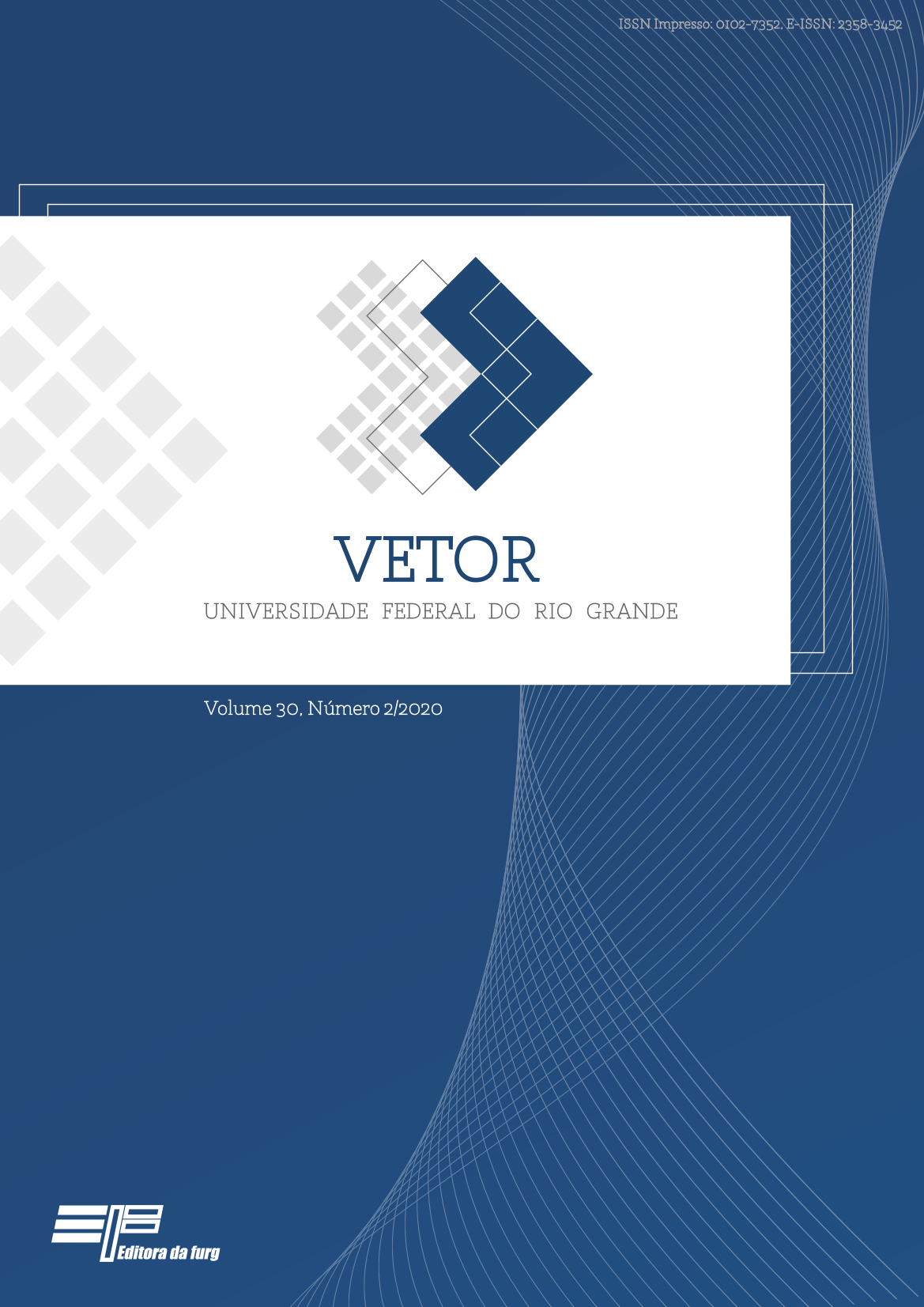Determination of the structural and mechanical characteristics of high entropy Hf-Nb-Ta-Zr alloy
DOI:
https://doi.org/10.14295/vetor.v30i2.13090Keywords:
High entropy alloy, Molecular dynamics, Nanoindentation, Hf-Nb-Ta-ZrAbstract
In this article, the structural and mechanical behavior of the high entropy equiatomic alloy Hf-Nb-Ta-Zr was studied by using molecular dynamics simulations. The simulations were carried out in the free code LAMMPS in a system composed of 154,000 atoms interacting under the Embedded Atom Method (EAM) potential. The study was mainly focused on the body-centered cubic structure (BCC). This structure shows the highest structural stability or the lowest potential energy at 0 K. The alloy was subjected to nanoindentation tests under a spherical virtual indenter with a diameter of 40 Å. All the indentation tests were carried out at a temperature of 10 K to eliminate the thermal contributions of atoms in three crystallographic planes (001), (011), and (111) to identify anisotropic effects. The structural evolution of the alloy was analyzed by using the partial radial distribution function (PRDF), total radial distribution function (TRDF), and X-ray diffraction. The loading-unloading curves showed that the nanoindentation on the surface corresponding to the (011) plane requires the largest indentation force, of about 142 nN, while the (111) plane leads to the most significant elastic deformation before the plastic deformation onset.
Downloads
References
J. W. Yeh, S. Chen, S.J. Lin, T.S. Chin, e T.T Shun, “Nanostructured high entropy alloys with multiple principal elements: novel alloy design concepts and outcomes”, Advanced Engineering Materials, vol. 6, no. 5, pp. 299–303, 2004. Disponível em: https://doi.org/10.1002/adem.200300567
M.C. Gao, J.-W. Yeh, P.K. Liaw, e Y. Zhang, High-Entropy Alloys, 1st ed. Londres, Inglaterra: Butterworth-Heinemann, 2014. Disponível em: https://doi.org/10.1007/978-3-319-27013-5
B. Cantor, I.T.H. Chang, P. Knight, e A.J.B. Vincent, “Microstructural development in equiatomic multicomponent alloys”, Materials Science and Engineering: A, vol. 375–377, no. 1, pp. 213–218, 2004. Disponível em: https://doi.org/10.1016/j.msea.2003.10.257
S. Maiti e W. Steurer. “Structural-disorder and its effect on mechanical properties in single-phase TaNbHfZr highentropy alloy”, Acta Materialia, vol. 106, no. 1, pp. 8797, 2016. Disponível em: https://doi.org/10.1016/j.actamat.2016.01.018
C.S. Schimidt, C. S., J.C.G. Tedesco, L.V.P.C. Lima, I.N. Bastos, P. Gargarella, e L.C.R. Aliaga. “Efeito da taxa de resfriamento na liga Ni80Cu20 via dinâmica molecular”, Revista Matéria, vol. 24, no. 1, pp. 1–11, 2019. Disponível em: http://dx.doi.org/10.1590/s1517-707620190001.0614
A. Leach, Molecular Modelling: Principles and Applications, 2nd ed. Nova Jersey, EUA: Prentice Hall, 2001. ISBN: UOM:39015055733078.
E. Paquet, e L.V. Herna, “Molecular dynamics, Monte Carlo simulations, and Langevin dynamics: A computational review”, BioMed Research International, vol. 2015, no. 9, pp. 1–18, 2015. Disponível em: https://doi.org/10.1155/2015/183918
S. Plimpton, “Fast parallel algorithms for short-range molecular dynamics”, Journal of Computational Physics, vol. 117, no. 1, pp. 1–19, 1995. Disponível em: https://doi.org/10.1006/jcph.1995.1039
S. Mishra, S. Maiti, D. Sridhar, e B. Rai, “Realistic microstructure evolution of complex Ta-Nb-Hf-Zr high-entropy alloys by simulation techniques”, Scientific Reports, vol. 9, 2019. Disponível em: https://doi.org/10.1038/s41598-019-52170-0
A. Stukowski, “Visualization and analysis of atomistic simulation data with OVITO-the Open Visualization Tool”, Modelling and Simulation in Materials Science and Engineering, vol. 18, no. 1, pp. 015012, 2009. Disponível em: http://dx.doi.org/10.1088/0965-0393/18/1/015012
H. Tsuzuki, P.S. Branicio, e J.P. Rino, “Structural characterization of deformed crystals by analysis of common atomic neighborhood”, Computer Physics Communications, vol. 177, no. 6, pp. 518–523, 2007. Disponível em: https://doi.org/10.1016/j.cpc.2007.05.018
A. Stukowski, e K. Albe, “Extracting dislocations and non-dislocation crystal defects from atomistic simulation data”, Modelling and Simulation in Materials Science and Engineering, vol. 18, no. 8, pp. 1–13, 2010. Disponível em: https://doi.org/10.1088/0965-0393/18/8/085001
X. Huang, L. Liu, X. Duan, W. Liao, J. Huang, H. Sun, e C. Yu. “Atomistic simulation of chemical short-range order in HfNbTaZr high entropy alloy based on a newly-developed interatomic potential”, Materials & Design, vol. 202 no. 1, pp. 109560, 2021. Disponível em: https://doi.org/10.1016/j.matdes.2021.109560
H.S. Oh, D. Ma, G.P. Leyson, B. Grabowski, E.S. Park, F. Kormann, e D. Raabe, “Lattice distortions in the FeCoNiCrMn high entropy alloy studied by theory and experiment”, Entropy, vol. 18, no. 9, pp. 1–18, 2016. Disponível em: https://doi.org/10.3390/e18090321
D. Farkas e A. Caro, “Model interatomic potentials and lattice strain in a high-entropy alloy”, Journal of Materials Research, vol. 33, no. 19, pp. 3218–3225, 2018. Disponível em: https://doi.org/10.1557/jmr.2018.245
J. Ding, Q. Yu, M. Asta, e R.O. Ritchie, “Tunable stacking fault energies by tailoring local chemical order in CrCoNi medium-entropy alloys”, Proceedings of the National Academy of Sciences, vol. 115, no. 36, pp. 8919–8924, 2018. Disponível em: https://doi.org/10.1073/pnas.1808660115
O.N. Senkov, S.V. Senkova, C. Woodward e D.B. Miracle, “Low-density, refractory multi-principal element alloys of the Cr–Nb–Ti–V–Zr system: Microstructure and phase analysis”, Acta Materialia, vol. 61, no. 5, pp. 1545–1557, 2013. Disponível em: http://dx.doi.org/10.1016/j.actamat.2012.11.032
L.C.R. Aliaga, C.S. Schimidt, L.V.P.C. Lima, P. Gargarella, I.N. Bastos e W.J. Botta, “Study of glass forming on Cu60.0Zr32.5Ti7.5 alloy by molecular dynamics simulation”, Materials Research, vol. 21, no. 2, pp. 20170555, 2017. Disponível em: https://doi.org/10.1590/1980-5373-mr-2017-0555
L.C.R. Aliaga, L.V.P.C. Lima, G.M.B. Domingues, I.N. Bastos, e G.A. Evangelakis, “Experimental and molecular dynamics simulation study on the glass formation of Cu–Zr–Al alloys”, Materials Research Express, vol. 6, no. 4, pp. 045202, 2019. Disponível em: https://doi.org/10.1088/2053-1591/aaf97e

















